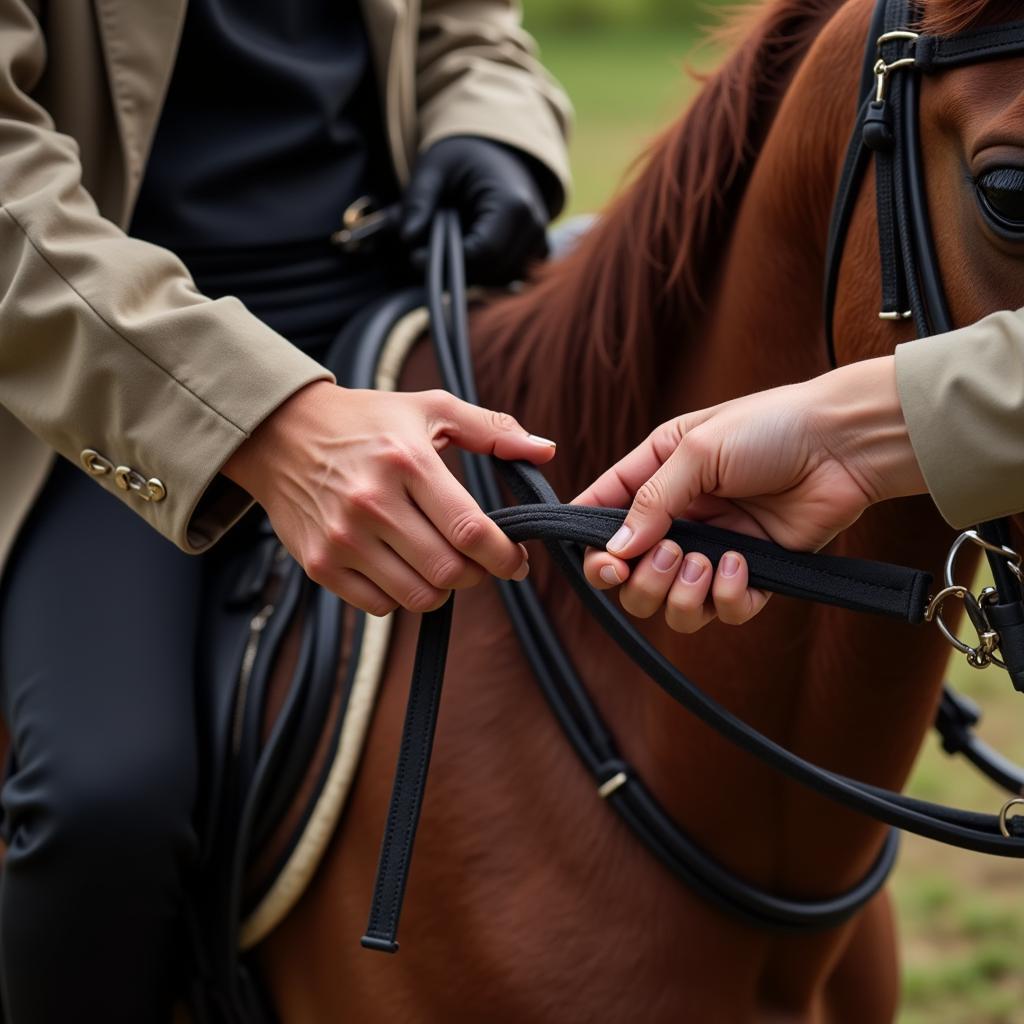Horse Jerking. The phrase alone evokes an unsettling feeling in most horse lovers. This action, often depicted as a harsh and forceful pull on the reins, raises immediate concerns about animal welfare. While the term itself might seem straightforward, the reality of horse jerking and its implications are far more nuanced.
What Exactly is Horse Jerking?
“Horse jerking” can refer to a range of actions applied to a horse’s mouth via the reins, bit, or other control devices. It can be a single, sharp pull, or a series of repeated jerks. The force and intent behind the action are crucial in determining whether it falls under acceptable riding practices or constitutes abuse.
 Horse and Rider with Reins
Horse and Rider with Reins
When Jerking is Considered Abuse
Let’s be clear: using excessive force on a horse’s sensitive mouth is unacceptable. It causes pain, distress, and can lead to long-term physical and psychological damage.
Some common situations where jerking crosses the line:
- Punishment: Jerking the reins out of frustration or anger is never acceptable. Horses learn best through positive reinforcement and consistent training, not punishment.
- Forceful Control: Using jerking to force a horse into submission or a desired gait is abusive and counterproductive. This heavy-handed approach damages trust and can lead to dangerous behavioral problems.
- Lack of Knowledge: Sometimes, inexperienced riders unintentionally jerk the reins due to poor balance or lack of coordination. While unintentional, this can still be harmful and requires immediate attention to improve riding skills.
When is Jerking Part of Riding?
There are instances where a quick, light action on the reins is necessary for communication and safety:
- Emergency Stops: In a dangerous situation, like a horse spooking into traffic, a firm, quick pull on the reins can be life-saving.
- Rein Aids: Experienced riders use subtle rein aids – barely perceptible to the untrained eye – to communicate with the horse and signal changes in direction or gait. These are not jerks, but rather clear, concise cues.
- Correcting a Dangerous Behavior: A quick, sharp pull accompanied by a vocal command can stop a horse from bolting or engaging in other dangerous behaviors. This should be done sparingly and only when other methods have failed.
It’s important to note that even these “acceptable” instances require a skilled and knowledgeable rider. The key difference lies in the intent, force, and execution of the action.
Alternatives to Jerking
Thankfully, there are numerous ways to communicate with and control a horse without resorting to jerking:
- Proper Training: A well-trained horse responds to light cues from the seat, legs, and reins. Investing in professional training is crucial for both horse and rider.
- Positive Reinforcement: Rewarding desired behaviors with praise, scratches, or treats is highly effective and builds a positive relationship between horse and rider.
- Bit Fitting: A poorly fitting bit can cause discomfort and pain, leading to resistance and the need for harsher rein aids. Consulting a qualified equine dentist or bit fitter is essential.
- O ring snaffle horse bit are a popular choice for their gentle action on the horse’s mouth.
Recognizing and Addressing Horse Jerking
As responsible equestrians, it’s our duty to recognize and address horse jerking. If you witness potential abuse:
- Document: If possible, gather evidence (photos, videos) while ensuring your own safety.
- Report: Contact your local animal control, humane society, or equine welfare organization.
- Educate: If you see someone unintentionally harming their horse due to lack of skill, kindly offer resources or suggest a qualified trainer.
FAQs About Horse Jerking
Q: Is jerking ever justified in horse training?
A: While some might argue for its use in specific training methods, many reputable trainers and organizations advocate for force-free approaches. Positive reinforcement and consistent communication are far more effective and humane.
Q: Can jerking cause permanent damage to a horse?
A: Yes. Repeated or severe jerking can lead to mouth injuries, dental problems, headshaking, and behavioral issues. It can also damage the trust and bond between horse and rider.
Q: What are some signs a horse is being jerked excessively?
A: Look for head tossing, gaping mouth, pinned ears, tail swishing, and reluctance to take the bit. These are all signs of discomfort or distress.
Conclusion
Horse jerking is a complex issue with no easy answers. While it might be necessary in rare, emergency situations, it should never be a routine part of riding or training. By prioritizing clear communication, positive reinforcement, and the well-being of our equine partners, we can create a world where horse jerking is recognized for what it truly is: an outdated and unacceptable practice.
Need help with a horse mounting aid? Or wondering about the ethics of a specific training tool, like a bit horse abuse? Justus Horses USA is here to provide you with the information and resources you need to be a responsible and compassionate horse owner.
For more insights on ethical horsemanship and training, explore our articles on woman jerks horse and long horse lead rope.
Have questions or need personalized advice? Contact our team at 0772127271, email us at [email protected], or visit us at QGM2+WX2, Vị Trung, Vị Thuỷ, Hậu Giang, Việt Nam. We’re available 24/7 to assist you in providing the best care for your equine companion.